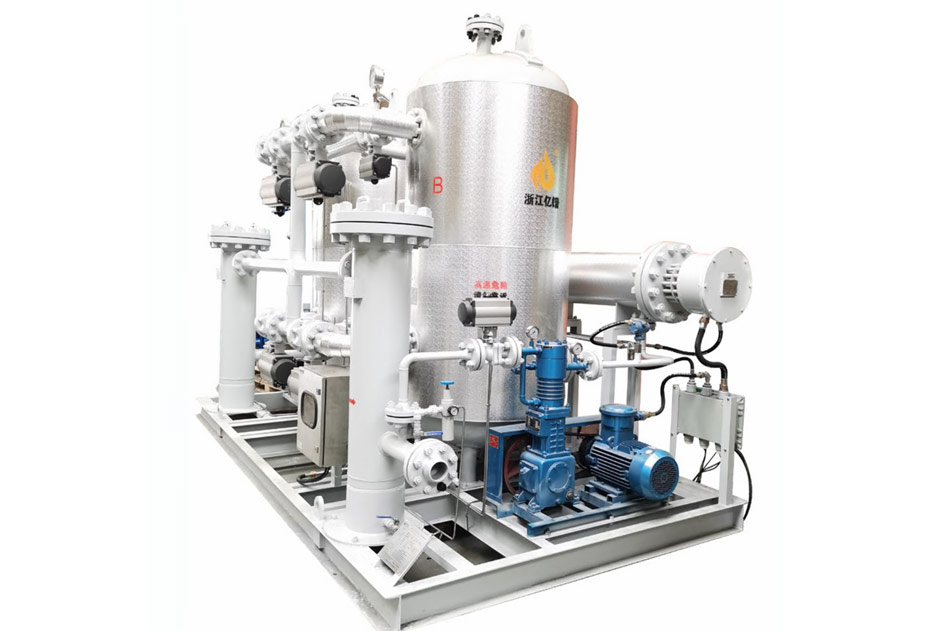Compressed Air Drying Solutions for the New Energy Industry
Industry Pain Points
Ultra-Low Dew Point Requirement: Lithium-ion battery production requires compressed air with a dew point of ≤-40℃ (some processes require -70℃), which traditional refrigerated dryers (+3℃) cannot meet at all.
Zero Oil Pollution Challenge: Electrode coaters are sensitive to oil content (requiring ≤0.001ppm). Conventional adsorbents are easily poisoned by oil mist and fail within 3 months.
High Energy Consumption: Air consumption for photovoltaic silicon wafer cutting is high (over 2000Nm³/h), and the power consumption of traditional adsorption drying accounts for 25% of the total energy consumption of the production line.
Hydrogen Safety Risk: Compressed air for electrolyzers has a hydrogen-containing risk (≥4% LEL, Lower Explosive Limit). Existing drying equipment lacks explosion-proof design, which may easily cause combustion and explosion accidents.
System Overview
Through the “catalytic oil removal – cryogenic pre-dehydration – green energy regeneration” technology loop, Yipu New Energy Compressed Air Drying System achieves:
- Process Upgrade: Breaks through the -70℃ dew point limit, enabling mass production of 6μm copper foil.
- Zero-Carbon Production: Driven by 100% renewable energy, meeting the requirements of RE100 certification.
- Intrinsic Safety: Comprehensive explosion protection from materials to control systems, with zero risk in hydrogen environments.
Solution Approach
Yipu New Energy Industry Compressed Air Drying Solution
| Module | Technical Highlights | Performance Indicators |
|---|---|---|
| Nano Oil Remover | Pt/TiO₂ catalyst, activated by UV light | Oil content ≤0.0001ppm, no consumables |
| Cryogenic Unit | Direct cooling at -60℃, COP ≥2.0 | Pre-cooling dew point -60℃, energy consumption reduced by 40% |
| Explosion-Proof Adsorption Tower | Fully stainless steel welding, Ex dⅡCT4+H2 explosion-proof certification | Outlet dew point -70℃, oil poisoning resistance service life of 5 years |
| Green Energy Electric Control | PV DC direct drive, supporting energy storage system for peak shaving | Off-grid operation capability ≥8h |
| Intelligent Interlock | Automatic tower switching when hydrogen concentration exceeds limits, response time ≤0.1s | SIL3 safety level |
Applicable Scenarios:
- Lithium battery electrode drying/injection
- Photovoltaic silicon wafer cutting/coating
- Air supply for hydrogen electrolyzers
- Fuel cell production lines
Technical Principles
Yipu Four-Stage New Energy-Specific Process:
- Nano-Level Oil Removal (Stage 1):The catalytic oxidation oil remover decomposes oil molecules into CO₂+H₂O, with residual oil ≤0.0001ppm and a 5-year service life without replacement.
- Deep Condensation (Stage 2):The cascade refrigeration system (R23+R404A) cools the air from 40℃ to -60℃, pre-removing 90% of moisture.
- Zero-Leakage Adsorption (Stage 3):Double-layer bed structure:
- Upper activated alumina intercepts remaining oil content
- Lower 3A-NE molecular sieves achieve an ultra-low dew point of -70℃
- Green Energy Regeneration (Stage 4):Uses on-site photovoltaic power to drive regeneration, achieving 100% energy saving compared with grid power supply.
Core Advantage
| Advantage | Details |
|---|---|
| Customized on Demand | Meets special working conditions; provides professional non-standard customization |
| Low Cost | Adopts cyclic regeneration process; significantly reduces operating costs |
| High Stability | Dual-tower structure with small pressure fluctuation; low noise and continuous gas supply |
| Fully Automatic Operation | Easy to operate, reducing labor input; improves efficiency |
| High Safety | Presets multi-level safety protection measures; supports automatic alarm |
| Low Failure Rate | Maintains low failure rate after 10,000 hours; high durability with almost no maintenance required |
Technical Strength
Leading Adsorption Dehydration Technology
Uses high-performance molecular sieve adsorbents with high water absorption capacity and resistance to corrosion by acidic gases (H₂S/CO₂), ensuring deep dehydration with a dew point ≤-70℃.
The original hot nitrogen regeneration process reduces energy consumption by 30% compared with traditional electric heating regeneration, and integrates a waste heat recovery system to significantly improve energy efficiency.
Modular and Customized Design Capability
Core equipment adopts modular prefabrication, supporting rapid deployment (installation cycle shortened by 50%) and adapting to diverse scenarios such as offshore platforms, onshore gas fields, and LNG pretreatment.
Can customize single-tower, dual-tower, or multi-tower parallel systems according to customer needs, with a treatment capacity ranging from 10,000 to 1,000,000 Nm³/d, flexibly matching gas fields of different scales.
Intelligent Control and Remote Operation & Maintenance
Equipped with a PLC+IoT intelligent control system, it real-time monitors key parameters such as pressure, temperature, and dew point, supporting fault early warning and automatic adjustment.
Through cloud-based big data analysis, it optimizes the adsorption-regeneration cycle, extends the service life of molecular sieves, and reduces operation and maintenance (O&M) costs by 10%-15%.
Energy-Saving and Environmental Protection Technology
Features zero-emission design for regeneration exhaust gas, complying with international environmental standards such as EU CE and US EPA.
Energy consumption is 25%-40% lower than that of traditional triethylene glycol (TEG) dehydration systems, helping customers achieve carbon emission reduction goals.
Long-Cycle Operation Reliability
Molecular sieves adopt anti-pulverization coating technology, with a service life of over 5 years, reducing replacement frequency.
Key components (e.g., valves, instruments) are selected from international first-tier brands (e.g., Siemens, Emerson), with a Mean Time Between Failures (MTBF) of over 100,000 hours.
Strong R&D and Engineering Experience
Possesses more than 19 patents and software copyrights in dehydration technology; the R&D team is led by doctors and has in-depth cooperation with universities and colleges.
Has over 1,000 successful cases worldwide, covering extreme working conditions such as high-sulfur gas fields in the Middle East and low-temperature environments in the Arctic.
Product Advantage Comparison
| Indicator | Yipu System | Traditional Refrigeration Type | Competitor Adsorption Type | Refrigeration + Adsorption Combination |
|---|---|---|---|---|
| Salt Spray Resistance | No corrosion at NaCl ≤15mg/m³ | Heat exchanger perforation in 3 months | Requires pre-filter (frequent replacement) | Not applicable |
| Dew Point | -70℃ (normal state) | -40℃ (requires frequent regeneration) | -20℃ | -60℃ (energy consumption doubled) |
| Residual Oil Content | ≤0.0001ppm | ≤0.01ppm (fails in 3 months) | ≤0.1ppm | ≤0.005ppm |
| Explosion-Proof Rating | Ex dⅡCT4+H2 | Non-explosion-proof | Not applicable | Only Ex dⅡBT4 |
| Energy Consumption | 0.12kWh/Nm³ (green power-driven) | 0.3kWh/Nm³ | 0.08kWh/Nm³ (insufficient dew point) | 0.45kWh/Nm³ |
| Carbon Footprint | 0kgCO₂/Nm³ (PV direct supply) | 0.28kgCO₂/Nm³ | 0.1kgCO₂/Nm³ | 0.35kgCO₂/Nm³ |
Typical Case
Project Name: A 64GWh Project at a CATL (Contemporary Amperex Technology Co., Limited) Base
Operating Conditions:
- Treatment Capacity: 18,000 Nm³/h, requiring dew point -60℃ and oil content ≤0.001ppm
- Explosion-Proof Requirement: Zone 1 in the electrolyte workshop
Dehydration Effect:
- Dew point stably maintained at -65℃, oil content at 0.0003ppm
- Electrode drying defect rate reduced from 3% to 0.02%
Economic Benefits:
- Annual electricity cost savings of 8.6 million yuan (compared with traditional adsorption)
- Reduced waste loss by 120 million yuan per year

